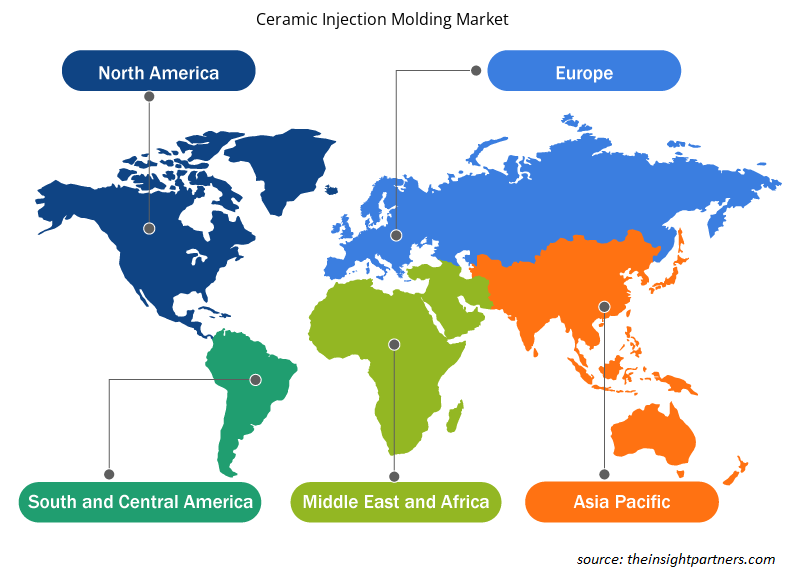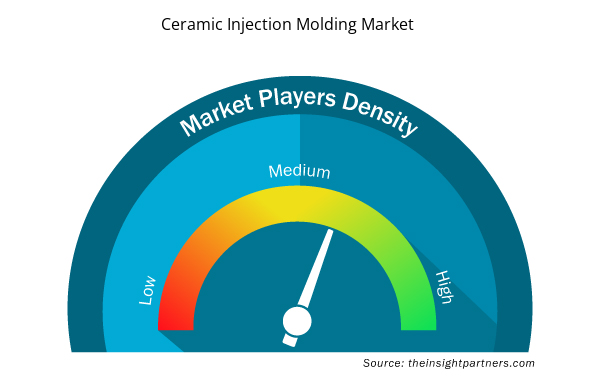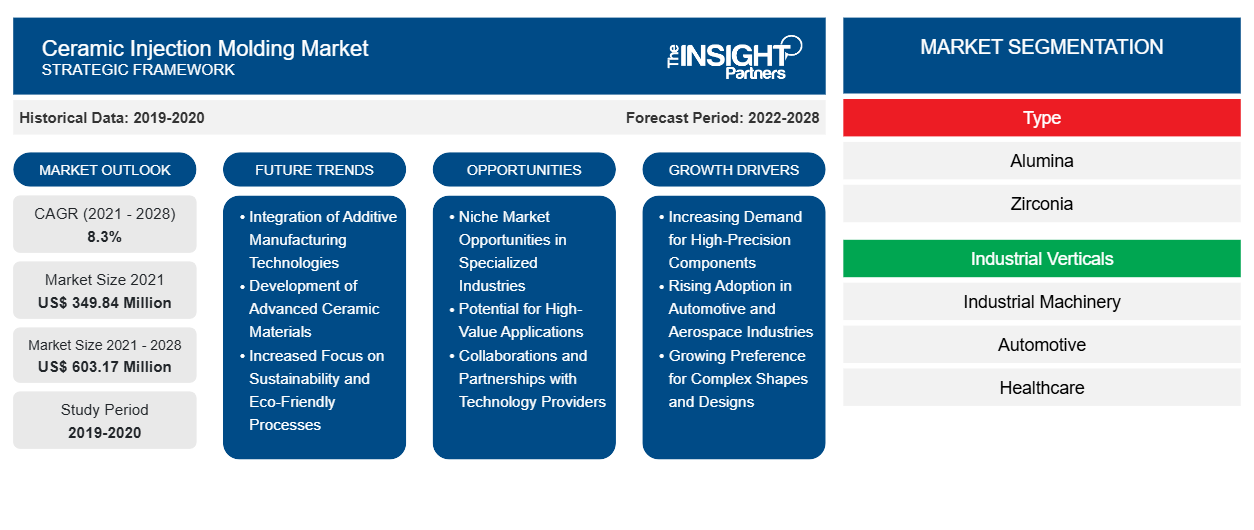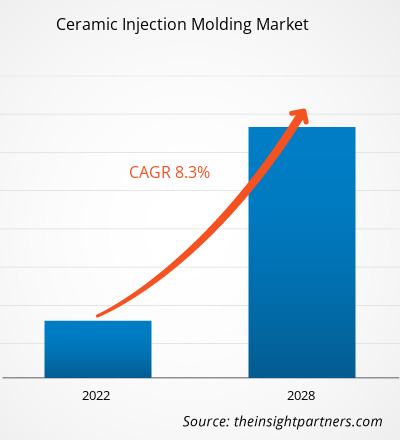陶瓷注塑市场规模预计将从 2021 年的 3.4984 亿美元增至 2028 年的 6.0317 亿美元。预计 2022 年至 2028 年的复合年增长率为 8.3%。
由于陶瓷注塑成型具有多种优势,陶瓷注塑成型的需求正在增长。发达地区和发展中地区汽车和电子行业陶瓷注塑成型应用的增加预计将为市场增长提供丰厚的机会。亚太地区在收入方面占据市场主导地位,预计在预测期内也将成为增长最快的地区。氧化铝部分在市场上占据主导地位。氧化锆部分的增长预计将对市场增长产生积极影响。
2021 年,欧洲占据全球陶瓷注塑市场的最大份额,预计亚太地区在预测期内的复合年增长率最快。2019 年,亚太地区在全球陶瓷注塑市场中占有最大份额。该地区陶瓷注塑市场的增长主要归因于氧化铝和氧化锆等陶瓷材料以较低的成本广泛供应。陶瓷注塑在医疗器械和消费电子产品生产中的应用不断扩大,有利于其在亚太地区的需求。技术的进步和先进产品使用趋势的上升推动了对陶瓷注塑的需求。除此之外,该工艺在医疗保健、工业机械、汽车和消费品中的应用不断增加,也是为该地区陶瓷注塑的增长提供充足机会的另一个因素。
定制此报告以满足您的需求
您可以免费定制任何报告,包括本报告的部分内容、国家级分析、Excel 数据包,以及为初创企业和大学提供优惠和折扣
- 获取此报告的关键市场趋势。这个免费样品将包括数据分析,从市场趋势到估计和预测。
市场洞察
汽车和电子行业更多地利用技术
陶瓷注塑成型在汽车、电子和消费品等行业中得到广泛应用。陶瓷注塑成型技术可以为电子、手机和消费品行业生产高精度、复杂的陶瓷部件和零件。过去几年,便携式计算设备、手机、游戏系统和其他个人电子设备的产量呈指数级增长。因此,这些产品的采用率上升推动了陶瓷注塑成型行业的扩张。快速的城市化进一步导致手机、电子产品、汽车等产品的采用率上升。汽车行业的巨大增长加上对这项技术的巨大生产需求正在刺激产生积极影响。由于模制微型产品具有高强度和结构复杂性,汽车行业对模制微型产品的需求正在不断增加。电子系统、发动机和锁定机构中复杂而重要的部件通常通过注塑成型工艺制造,这是扩大陶瓷注塑成型市场的重要驱动力。技术陶瓷在高温、腐蚀性环境和磨蚀性条件等极端条件下也能有效发挥作用。此外,先进陶瓷还具有出色的机械特性和较低的比重。由于先进陶瓷的这一特性,它们被认为是轻质建筑材料,因此可用于移动航空和汽车部件以及发动机部件。此外,发展中地区可支配收入的增加和生活水平的提高正在促进这些终端用户行业的发展,最终扩大市场增长。
基于类型的洞察
根据类型,陶瓷注塑市场分为氧化铝、氧化锆和其他。2021 年,氧化铝部分占据了最大的市场份额。 氧化锆部分预计在预测期内将实现最高的复合年增长率。 氧化锆也称为氧化锆,是指锆的白色结晶氧化物。 矿物斜锆石是最天然存在的氧化锆形式,具有单斜晶体结构。 氧化锆陶瓷粉末广泛用于注塑成型。 与氧化铝相比,氧化锆具有更大的热膨胀能力。 它具有生物相容性,具有高化学惰性、高抗断裂性和低导热性。 氧化锆粉末用于通过注塑成型生产牙种植体。 使用氧化钇稳定的四方氧化锆生产陶瓷注塑件似乎是可行的。氧化钇稳定四方氧化锆零件的强度和可变性通常高于其他传统零件。莫来石氧化锆因其高抗热震性、高温强度和低热膨胀系数而被视为高温结构行业垂直领域的潜在材料。注塑中使用的氧化锆粉末能够制造由莫来石氧化锆复合材料制成的复杂形状。氧化锆粉末主要用于光纤套管和引线键合喷嘴的注塑成型。氧化锆增韧氧化铝陶瓷由于硬度高、强度高和耐磨性好,是生物医学和工程行业垂直领域的有趣材料。因此,陶瓷注塑似乎是生产氧化锆增韧氧化铝的一个有吸引力的选择。氧化锆主要用于氧化铝强度被认为不足的行业垂直领域。
类别洞察
基于垂直行业的洞察
根据工业垂直领域,陶瓷注塑市场细分为工业机械、汽车、医疗保健、电气和电子产品、消费品等。医疗保健部门在 2020 年占据了最大的市场份额。陶瓷注塑在牙科植入物、镊子、内窥镜工具和其他应用中的使用支持了医疗保健行业对陶瓷注塑的市场。氧化锆和氧化铝的氧化物用于制造许多器具,这进一步推动了医疗保健行业对陶瓷注塑的需求。陶瓷注塑工艺能够调节医疗保健应用中使用的组件的粗糙度和表面质量,从而支持了市场的增长。医疗保健行业的不断发展是为该细分市场的发展提供丰厚机会的另一个因素。此外,微陶瓷注塑件的形成及其在医疗保健行业使用的各种产品中的应用促进了陶瓷注塑市场中医疗保健细分市场的增长。
陶瓷注塑市场的主要参与者包括 AMT Pte. Ltd.;Arburg GmbH + Ko. KG.;Ceramco, Inc.;CoorsTek, Inc.;Indo MIM;KLAGER;Micro;Morgan Advanced Materials;Nishimura;Advanced Ceramics, Co. Ltd.;和 OECHSLER AG。这些公司正致力于新产品的推出和地域扩张,以满足全球日益增长的消费者需求。它们在全球拥有广泛的业务,这使其能够为全球大量客户提供服务,从而增加其市场份额。这些市场参与者高度重视新产品的推出和区域扩张,以增加其专业产品组合的产品范围。
陶瓷注塑市场区域洞察
Insight Partners 的分析师已详尽解释了预测期内影响陶瓷注塑成型市场的区域趋势和因素。本节还讨论了北美、欧洲、亚太地区、中东和非洲以及南美和中美洲的陶瓷注塑成型市场细分和地理位置。

- 获取陶瓷注塑市场的区域特定数据
陶瓷注射成型市场报告范围
| 报告属性 | 细节 |
|---|---|
| 2021 年市场规模 | 3.4984亿美元 |
| 2028 年市场规模 | 6.0317亿美元 |
| 全球复合年增长率(2021 - 2028) | 8.3% |
| 史料 | 2019-2020 |
| 预测期 | 2022-2028 |
| 涵盖的领域 | 按类型
|
| 覆盖地区和国家 | 北美
|
| 市场领导者和主要公司简介 |
|
市场参与者密度:了解其对商业动态的影响
陶瓷注塑市场正在快速增长,这得益于终端用户需求的不断增长,而这些需求又源于消费者偏好的不断变化、技术进步以及对产品优势的认识不断提高等因素。随着需求的增加,企业正在扩大其产品范围,进行创新以满足消费者的需求,并利用新兴趋势,从而进一步推动市场增长。
市场参与者密度是指在特定市场或行业内运营的企业或公司的分布情况。它表明在给定市场空间中,相对于其规模或总市场价值,有多少竞争对手(市场参与者)存在。
在陶瓷注塑市场运营的主要公司有:
- AMT 私人有限公司
- Arburg GmbH + Ko. KG.
- Ceramco 公司
- CoorsTek 公司
- 印度MIM
免责声明:上面列出的公司没有按照任何特定顺序排列。

- 了解陶瓷注塑市场主要参与者概况
报告亮点
- 陶瓷注塑市场进步的行业趋势,帮助企业制定有效的长期战略
- 发达国家和发展中国家陶瓷注塑市场参与者采用的业务增长战略
- 2019 年至 2028 年市场定量分析
- 全球陶瓷注塑产品需求量估计
- 波特五力分析说明陶瓷注塑市场中买家和供应商的效力
- 了解竞争市场状况的最新发展
- 市场趋势和前景,以及推动和抑制陶瓷注塑市场增长的因素
- 通过强调支撑商业利益的市场策略来协助决策过程
- 陶瓷注塑成型市场不同节点的规模
- 陶瓷注塑行业详细概述和动态
- 各地区陶瓷注塑市场规模及增长潜力巨大
- 历史分析(2 年)、基准年、预测(7 年)及复合年增长率
- PEST 和 SWOT 分析
- 市场规模价值/数量 - 全球、区域、国家
- 行业和竞争格局
- Excel 数据集


- Aesthetic Medical Devices Market
- Smart Grid Sensors Market
- Data Center Cooling Market
- Analog-to-Digital Converter Market
- Nuclear Waste Management System Market
- Lymphedema Treatment Market
- Medical and Research Grade Collagen Market
- Saudi Arabia Drywall Panels Market
- Europe Industrial Chillers Market
- Fish Protein Hydrolysate Market

Report Coverage
Revenue forecast, Company Analysis, Industry landscape, Growth factors, and Trends

Segment Covered
This text is related
to segments covered.

Regional Scope
North America, Europe, Asia Pacific, Middle East & Africa, South & Central America

Country Scope
This text is related
to country scope.
常见问题
Rising awareness regarding the design flexibility and low-cost delivered by ceramic injection molding are estimated to provide potential market opportunities in the coming years. Various key players such as Indo-MIM, Coorstek, Inc., and many others are providing awareness regarding the cost-efficiency of the technology. Besides, the cost efficiency and complex designing capabilities of ceramic injection molding technology offer a higher economy of scale by eliminating the production steps such as machining and finishing. Ceramic injection molding is an innovative technology that provides economical solutions to produce complicated, repeatable ceramic parts and components. Also, the ceramic injection molding process is a highly flexible process to manufacture products that are considered difficult and expensive to produce using other conventional manufacturing techniques.
Based on the industrial verticals, healthcare segment is projected to grow at the fastest CAGR over the forecast period. The use of ceramic injection molding in prosthetic components offers the possibility to modulate the roughness or the surface quality on a singular component for combining various materials that can portray more homogenous mechanical properties. The simple shaped ceramic components for prosthetic dental components are manufactured by ceramic injection molding. Several injection molding zirconia ceramic tweezers pincers are also manufactured by many companies. Endoscopic ceramic insulators produced by ceramic injection molding are increasing adopted in the endoscopic surgeries conducted in hospitals.
Ceramic advantages offered by the ceramic injection molding is driving the ceramic injection molding market. ceramic injection molding employs dependable equipment and advanced ceramic materials as well as compounds to produce ceramic components in a carefully controlled environment. This results in products of exceptional quality that meets the quality and aesthetic standards specific to a particular industry. Besides, businesses attain financial benefits from high-volume manufacturing, especially if they require new components as an alternative to existing designs. In addition, ceramic injection molding also helps acquire custom-made moldings of exceptional durability that meet all the required industry criteria. Also, ceramic injection molding components offer all the benefits associated with technical ceramics, including corrosion resistance, wear resistance, superior hardness, thermal stability, high mechanical strength, and dimensional stability. Thus, the advantages offered by ceramic injection molding is augmenting the growth of the market.
The major players operating in the global ceramic injection molding market are AMT Pte. Ltd.; Arburg GmbH + Ko. KG.; Ceramco, Inc.; CoorsTek, Inc.; Indo MIM; KLAGER; Micro; Morgan Advanced Materials; Nishimura; Advanced Ceramics, Co. Ltd.; and OECHSLER AG
Europe accounted for the largest share of the global ceramic injection molding market. Europe has matured the automotive, aerospace, medical, and consumer electronics sector, and it is further supported by high technology connectivity environment. Along with the advancing technology, the trend of using advanced products is boosting the demand for ceramic materials and further influencing the market growth for the ceramic injection molding market. Additionally, the rising personal disposable income of the consumers has led to increasing demand for consumer electronic products. These factors boost the ceramic injection molding market in Europe.
Based on type, alumina segments mainly have the largest revenue share. The alumina components that are employed in ceramic injection molding possess high wear & corrosion stability, high surface finish quality and good electrical insulation. They are stable dimensionally and has the capacity to withstand high working temperatures. Owing to the good mechanical properties along with low specific weight, the ceramic injection molding alumina is used in engineering for sensor tubes, sensor covers and micro electrodes for ultrasonic welding. It is also used in textile industry for wire guides and textile thread guides. In electrical components it is used for microwave electric components. Ceramic insulation molding alumina is being highly demanded as it the most common used material in micro-CIM and 2C-CIM technologies.
Trends and growth analysis reports related to Chemicals and Materials : READ MORE..
The List of Companies - Ceramic Injection Molding Market
- AMT Pte. Ltd.
- Arburg GmbH + Ko. KG.
- Ceramco, Inc.
- CoorsTek, Inc.
- Indo MIM
- KLAGER
- Micro
- Morgan Advanced Materials
- Nishimura Advanced Ceramics, Co. Ltd.
- OECHSLER AG
The Insight Partners performs research in 4 major stages: Data Collection & Secondary Research, Primary Research, Data Analysis and Data Triangulation & Final Review.
- Data Collection and Secondary Research:
As a market research and consulting firm operating from a decade, we have published and advised several client across the globe. First step for any study will start with an assessment of currently available data and insights from existing reports. Further, historical and current market information is collected from Investor Presentations, Annual Reports, SEC Filings, etc., and other information related to company’s performance and market positioning are gathered from Paid Databases (Factiva, Hoovers, and Reuters) and various other publications available in public domain.
Several associations trade associates, technical forums, institutes, societies and organization are accessed to gain technical as well as market related insights through their publications such as research papers, blogs and press releases related to the studies are referred to get cues about the market. Further, white papers, journals, magazines, and other news articles published in last 3 years are scrutinized and analyzed to understand the current market trends.
- Primary Research:
The primarily interview analysis comprise of data obtained from industry participants interview and answers to survey questions gathered by in-house primary team.
For primary research, interviews are conducted with industry experts/CEOs/Marketing Managers/VPs/Subject Matter Experts from both demand and supply side to get a 360-degree view of the market. The primary team conducts several interviews based on the complexity of the markets to understand the various market trends and dynamics which makes research more credible and precise.
A typical research interview fulfils the following functions:
- Provides first-hand information on the market size, market trends, growth trends, competitive landscape, and outlook
- Validates and strengthens in-house secondary research findings
- Develops the analysis team’s expertise and market understanding
Primary research involves email interactions and telephone interviews for each market, category, segment, and sub-segment across geographies. The participants who typically take part in such a process include, but are not limited to:
- Industry participants: VPs, business development managers, market intelligence managers and national sales managers
- Outside experts: Valuation experts, research analysts and key opinion leaders specializing in the electronics and semiconductor industry.
Below is the breakup of our primary respondents by company, designation, and region:

Once we receive the confirmation from primary research sources or primary respondents, we finalize the base year market estimation and forecast the data as per the macroeconomic and microeconomic factors assessed during data collection.
- Data Analysis:
Once data is validated through both secondary as well as primary respondents, we finalize the market estimations by hypothesis formulation and factor analysis at regional and country level.
- Macro-Economic Factor Analysis:
We analyse macroeconomic indicators such the gross domestic product (GDP), increase in the demand for goods and services across industries, technological advancement, regional economic growth, governmental policies, the influence of COVID-19, PEST analysis, and other aspects. This analysis aids in setting benchmarks for various nations/regions and approximating market splits. Additionally, the general trend of the aforementioned components aid in determining the market's development possibilities.
- Country Level Data:
Various factors that are especially aligned to the country are taken into account to determine the market size for a certain area and country, including the presence of vendors, such as headquarters and offices, the country's GDP, demand patterns, and industry growth. To comprehend the market dynamics for the nation, a number of growth variables, inhibitors, application areas, and current market trends are researched. The aforementioned elements aid in determining the country's overall market's growth potential.
- Company Profile:
The “Table of Contents” is formulated by listing and analyzing more than 25 - 30 companies operating in the market ecosystem across geographies. However, we profile only 10 companies as a standard practice in our syndicate reports. These 10 companies comprise leading, emerging, and regional players. Nonetheless, our analysis is not restricted to the 10 listed companies, we also analyze other companies present in the market to develop a holistic view and understand the prevailing trends. The “Company Profiles” section in the report covers key facts, business description, products & services, financial information, SWOT analysis, and key developments. The financial information presented is extracted from the annual reports and official documents of the publicly listed companies. Upon collecting the information for the sections of respective companies, we verify them via various primary sources and then compile the data in respective company profiles. The company level information helps us in deriving the base number as well as in forecasting the market size.
- Developing Base Number:
Aggregation of sales statistics (2020-2022) and macro-economic factor, and other secondary and primary research insights are utilized to arrive at base number and related market shares for 2022. The data gaps are identified in this step and relevant market data is analyzed, collected from paid primary interviews or databases. On finalizing the base year market size, forecasts are developed on the basis of macro-economic, industry and market growth factors and company level analysis.
- Data Triangulation and Final Review:
The market findings and base year market size calculations are validated from supply as well as demand side. Demand side validations are based on macro-economic factor analysis and benchmarks for respective regions and countries. In case of supply side validations, revenues of major companies are estimated (in case not available) based on industry benchmark, approximate number of employees, product portfolio, and primary interviews revenues are gathered. Further revenue from target product/service segment is assessed to avoid overshooting of market statistics. In case of heavy deviations between supply and demand side values, all thes steps are repeated to achieve synchronization.
We follow an iterative model, wherein we share our research findings with Subject Matter Experts (SME’s) and Key Opinion Leaders (KOLs) until consensus view of the market is not formulated – this model negates any drastic deviation in the opinions of experts. Only validated and universally acceptable research findings are quoted in our reports.
We have important check points that we use to validate our research findings – which we call – data triangulation, where we validate the information, we generate from secondary sources with primary interviews and then we re-validate with our internal data bases and Subject matter experts. This comprehensive model enables us to deliver high quality, reliable data in shortest possible time.


 获取此报告的免费样本
获取此报告的免费样本